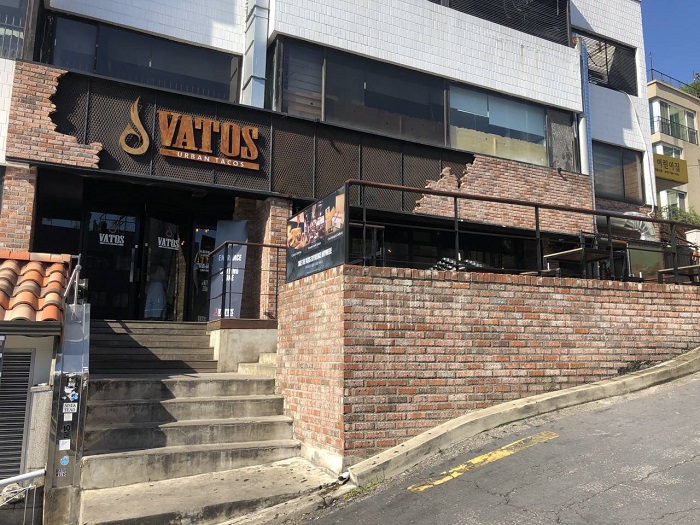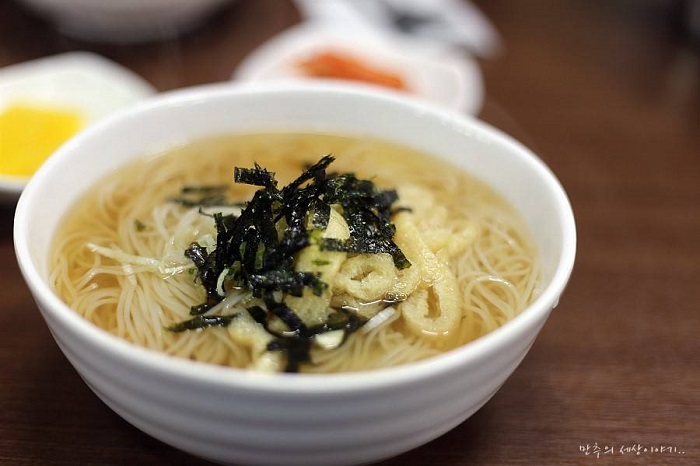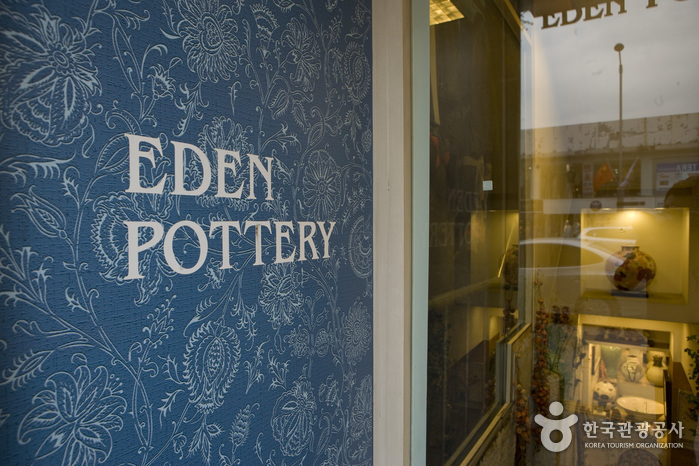VATOS (바토스)
3.9Km 2021-03-29
1, Itaewon-ro 15-gil, Yongsan-gu, Seoul
+82-2-797-8226
It serves new-concept dishes by combining Korean flavors with traditional Mexican dishes. This Western dishes restaurant is located in Yongsan-gu, Seoul. The most famous menu is cheese nacho.
Godae ap Myeolchi Guksu (고대앞멸치국수)
3.9Km 2021-03-26
2, Jegi-ro, Dongdaemun-gu, Seoul
+82-2-953-1095
It is a restaurant featured in the cartoon “Sikgaek.” This Korean dishes restaurant is located in Dongdaemun-gu, Seoul. The representative menu is noodles in anchovy broth.
KERVAN RESTAURANT (케르반레스토랑)
3.9Km 2021-04-13
190, Itaewon-ro, Yongsan-gu, Seoul
Kervan is a restaurant specializing in Turkish cuisine, which is widely enjoyed around the world. The kitchen is run by a skilled native chef, and has ovens manufactured with Turkish technology. The interior of the restaurant is decorated with traditional Turkish tiles, giving restaurant patrons the opportunity to sample authentic cuisine and decorative elements of Turkish culture together. The restaurant has also obtained the official Halal Certificate recognition.
ABC-Mart - Itaewon Branch [Tax Refund Shop] (ABC마트 ST이태원)
3.9Km 2024-04-22
159-1, Itaewon-ro, Yongsan-gu, Seoul
-
Kervan Turkish Restaurant (케르반레스토랑)
3.9Km 2025-03-15
192 Itaewon-ro, Yongsan-gu, Seoul
Kervan is a Turkish restaurant located in Itaewon, offering authentic kebab, pidé, and Turkish desserts. It faithfully recreates the Turkish culture and food through its interior, decorated with traditional tiles, and dishes prepared by a chef from Türkiye. Main menus include Chicken steak, Rich pidé, and Chicken shish kebab.
Eden Pottery (에덴도자기)
3.9Km 2016-08-24
159-1, Itaewon-ro, Yongsan-gu, Seoul
+82-2-793-0828
Eden Pottery specializes in Korean pottery from celadon to white porcelains. The shop is full of superb Korean pottery in its gallery-like atmosphere. Customers will be exposed to the rich history of Korean pottery and its diverse types. Products are made by experienced craftsmen.
Itaewon Special Tourist Zone (이태원 관광특구)
3.9Km 2024-11-27
196 Itaewon-ro, Yongsan-gu, Seoul
Itaewon was the first special tourist zone in Seoul, designated in 1997. It is a multicultural place where over 20,000 foreigners live and is widely recognized by international visitors.
The name Itaewon started to spread worldwide in the 1980s when Korea hosted the 1986 Seoul Asian Games and the 1988 Seoul Olympic Games, as well as many international conferences. Since then, Itaewon has become a popular travel destination. Clothes and accessories with unique designs, and leather products in particular are famous. This is a go-to place for both shopping and entertainment. The street is crowded with shops selling clothes and bags, as well as hotels, restaurants, entertainment facilities and travel agencies. With about 2,000 shops and stores lining every street, visitors can experience a multicultural atmosphere. Also famous in the district is Antique Furniture Street where more than 100 shops selling furniture and antiques stretch from Hamilton Hotel toward Bogwang-ro.
Travelers can taste authentic cuisine and experience culture from around the globe on World Food Street where there are 40 restaurants operated by foreigners. Since the late 1990s, an increase in the number of tourists from Southeast Asia and the Middle East has transformed the streets from being US Army-oriented into culturally diverse. Various performances and events are held in the area. In particular, Itaewon Global Village Festival, held every October, is a famous festival. Tourists can pay in US dollars, Japanese yen, or another currency freely. In addition, visitors can use various languages like English, Japanese, and Chinese with the sellers.
Olive Young - Itaewon Branch [Tax Refund Shop] (올리브영 이태원입구)
3.9Km 2024-04-18
1F, 145, Itaewon-ro, Yongsan-gu, Seoul
-
Seoul Yangnyeongsi Market (서울 약령시장)
3.9Km 2021-06-09
10, Yangnyeongjungang-ro, Dongdaemun-gu, Seoul
+82-2-969-4793
"Yangnyeongsi," which literally means medicine city district, refers to a central Oriental medicine district formed near major cities where medicinal herbs are collected and produced. Yangneongsi were first established by royal order during the Joseon dynasty for the purpose of effective production, distribution and management of medicinal products and herbs.
Seoul Yangnyeongsi Market history is relatively short, having formed naturally in the mid-1960s by medicinal herb merchants who gathered here seeking to sell their products with the city bus terminal and Cheongnyangni Station as their central base. Originally, these merchants came to Seoul through the old Seongdong Station and Chyeongnyangni Station after the Korean War, seeking to sell medicinal herbs and vegetation products that were cultivated and collected in the Gyeonggi-do and Gwangwon-do regions. This small market that was once open on an empty plot of land was later authorized as an official market establishment. Road and railroad developments between Gangwon-do and Seoul were followed and by the 1970s, the market grew into what is now seen today. The name Seoul Yangnyeongsi Market was given by the Seoul mayor in 1995.
Wang Thai (왕타이)
3.9Km 2021-05-14
151, Itaewon-ro, Yongsan-gu, Seoul
+82-2-749-2746
Wang Thai serves authentic Thai food with over 100 menus by professional Thai chefs. The restaurant offers about 80 seats with Thai decorations, giving off an exotic atmosphere. The restaurant earned the Thai Select, a certificate of authentic Thai cuisine given out by the Thailand Government.



![ABC-Mart - Itaewon Branch [Tax Refund Shop] (ABC마트 ST이태원)](http://tong.visitkorea.or.kr/cms/resource/73/2878473_image2_1.jpg)

![Olive Young - Itaewon Branch [Tax Refund Shop] (올리브영 이태원입구)](http://tong.visitkorea.or.kr/cms/resource/82/2878482_image2_1.jpg)
 English
English
 한국어
한국어 日本語
日本語 中文(简体)
中文(简体) Deutsch
Deutsch Français
Français Español
Español Русский
Русский